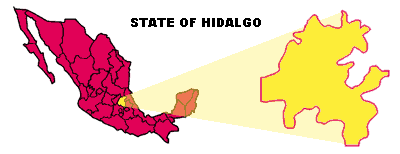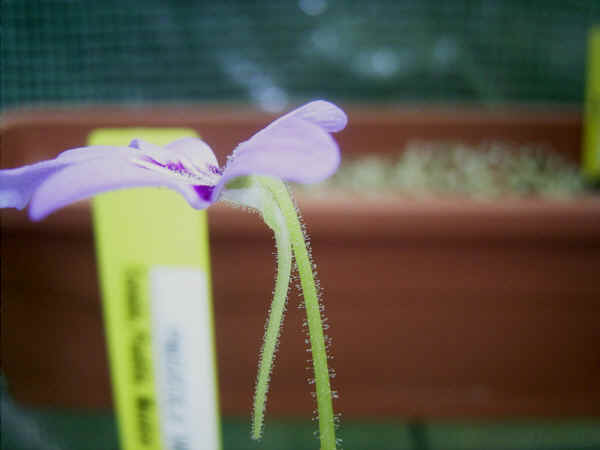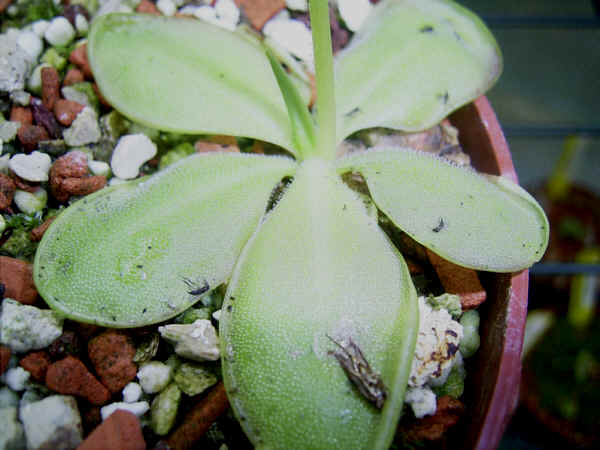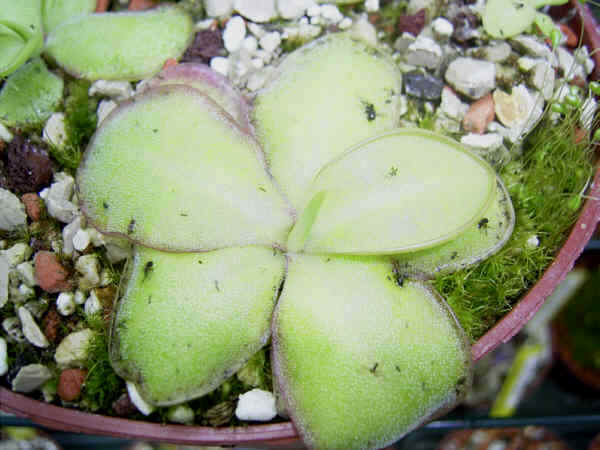The plants have been
collected in Mexico by A. Lux (the describer of P. immaculata) about more
than 10 years ago (before 1994 ?) and were grown in culture by Andrej Pavlovic.
Jan Flisek was given leaves from these clones that according to him are all
differents. He named the cultivars 'ANPA A', 'ANPA B', 'ANPA C', 'ANPA D' (ANPA
from ANdrej PAvlovic, and the letter for the clones A, B, C, D).
Life
cycle :
The
life cycle observed in culture for this Pinguicula
consists of two seasons, one wet and the other dry (see link). The plant forms different
leaf rosettes according to the season. During the resting months (winter) the
small succulent rosette is composed of numerous non-carnivorous leaves. The
carnivorous leaves are produced in spring and during all summer. The life
cycle of the plant is probably similar in it's native habitat.
Media
: I use a 100 % mineral media :
2 perlite, 2 vermiculite, 1 small sand (for aquarium), 1 fine white sand, 1
pouzzolane (volcanic lava), 1 aqualit (expansed ceramic for aquarium). The
aqualit can be replaced by 1 of pouzzolane. Plants in this media grow slower
but have a stronger root system.
Pot
: plastic,
colour terracotta, diameter 12.5cm, height 12cm.
Cultivation
:
I
think that a slightly airy situation inside the greenhouse is important
to avoid air stagnation. For this reason, I use a fan 24h/24h all the year
round.
Watering
is very important : from
May to September (summer). I let the media drying slightly between two watering. I use rain water poured on the top of the pot taking care
not to wet the rosette. From October to April, It is important to let
the media drying completely (no watering) but with an atmospheric humidity of
about 80%.
The mentioned months are indicative and can change
according to your own growing conditions. In fact, when this Pinguicula
begins to produce its non-carnivorous leaves, you have to stop watering and
let the pot drying out completely. Inversely, when the plant begins to produce
in early spring its carnivorous leaves, you have to progressively start
watering again the pot.
Temperatures : during
growth period, day temperatures are about 25°C but can reach 35°C when the
sun is shining on the greenhouse in spite of the use of shading covers.
Night temperatures are around 20°C. During
resting period : day/night over freezing point. Lower temperature
observed : - 4°C. I use an electronic petroleum heater to provide heat.
Multiplication
: No data about
sexual pollinating. The plants can be propagated easily using non-carnivorous
leaves separated from the rosette at the end of winter. You only have to carefully
tear out the totality of the leaf including the white base as the plantlets
will sprout from this area.
| Pinguicula 'ANPA'
in its original habitat (it is a population of P. moranensis) |
|
.jpg)
The original habitat of the
collected Pinguicula 'ANPA'.
Site of P.
moranensis (ANPA) is almost in the middle between Eloxochitlán and
Molango.
There are wide
mountains chains. Site of butterworts is marked by arrow. Hidalgo state,
Mexico, 1746 m above see level.
Photo : Radek KASTNER
July-August 2009
|
|
.jpg)
Site is located on the vertical rocky cliffs, there are
some hundreds meters long and are ca between 15-30 meters tall.
Photo : Radek KASTNER
July-August 2009
|
.jpg)
Surface is mostly
bare, but the wetest places are covered by moss. The upper part of the hills
is mostly deciduous forest with epiphytic orchids etc.)
Photo : Radek KASTNER
July-August 2009
|
|
.jpg)
Pinguicula moranensis growing on
mosses.
Photo : Radek KASTNER
July-August 2009 |
.jpg)
You can find, on
the vertical cliffs population of Agave stricta as well.
Photo : Radek KASTNER
July-August 2009
|
.jpg)
Pinguicula moranensis growing on mosses.
Photo : Radek KASTNER
July-August 2009 |
.jpg)
The most wonderful thing
was the variability of their flowers and rosettes (shape and colors as well).
You can find here completely dark red or purple rosettes, reddish, greenish
or green, green with red margins etc. Coloration of flowers was beautiful
and it has to be said, that all this different clones were growing at the
same place.
Photo : Radek KASTNER
July-August 2009
|
.jpg)
Some plants were growing on dryier places, on the bare
rock, in the crevices etc., but it seems, that this places have to be wet
for some time during the year. Nice coloured rosette with common flower,
above this plant you can see greenish plant with red margins.
Photo : Radek KASTNER
July-August 2009 |
.jpg)
Biggest part of population of butterworts is placed on
surface covered by moss, which is very wet. There were thousands of plants,
many of them in flower. Many plants have had strong elongated and narrow
leaves, another plants had almost typical P. moranensis rosettes...
Photo : Radek KASTNER
July-August 2009
|
.jpg)
Biggest part of
population of butterworts is placed on surface covered by moss, which is
very wet. There were thousands of plants, many of them in flower. Many
plants have had strong elongated and narrow leaves, another plants had
almost typical P. moranensis rosettes...
Photo : Radek KASTNER
July-August 2009 |
.jpg)
On the left side you can see the common coloration of
plants at that site, but straight away you may see completely white flowered
plants, which are in cultivation known under name
P. moranensis "Molango", but
all different colours or patterns are growing here as well !
Photo : Radek KASTNER
July-August 2009
|
.jpg)
Pinkish white flower with violet
spots, greenish rosette with red margins.
Photo : Radek KASTNER
July-August 2009 |
.jpg)
Almost typical plant.
Photo : Radek KASTNER
July-August 2009 |
.jpg)
I
Interesting
coloured plant with many mucus and with wavy leafs...
Photo : Radek KASTNER
July-August 2009 |
.jpg)
Really interesting coloured
(violet-pinkish) and shaped flower.
Photo : Radek KASTNER
July-August 2009
|
.jpg)
Different
rosettes colour. Plants with have a lot of mucus, when they are in really
moist conditions.
Photo : Radek KASTNER
July-August 2009
|
.jpg)
Some very dark red coloured
rosettes.
Plants have a lot of mucus, when
they are in really moist conditions.
Photo : Radek KASTNER
July-August 2009
|
.jpg)
Some very dark red coloured
rosettes.
Plants have a lot of mucus, when
they are in really moist conditions.
Photo : Radek KASTNER
July-August 2009 |
.jpg)
"like P. crystallina"
coloured flower, of course not in shape and with missing yellow spot in the
middle.
Photo : Radek KASTNER
July-August 2009 |
.jpg)
You can find, on
the vertical cliffs population of Agave stricta as well.
Photo : Radek KASTNER
July-August 2009 |
.jpg)
Biggest part of population of butterworts is placed on
surface covered by moss, which is very wet. There were thousands of plants,
many of them in flower. Many plants have had strong elongated and narrow
leaves, another plants had almost typical P. moranensis rosettes...
Photo : Radek KASTNER
July-August 2009
|
.jpg)
In lower part of
vertical cliffs was growing dense shrubby, grassy and herbal vegetation.
Photo : Radek KASTNER
July-August 2009 |
.jpg)
Rock surface was
here very dry and behind the vegetation were very shaded places, but as you
can see, in that conditions were the plants growing as well.
Photo : Radek KASTNER
July-August 2009
|
.jpg)
P. moranensis
growing on dry rock surface among dense shrubby, grassy and herbal
vegetation.
Photo : Radek KASTNER
July-August 2009 |
|

.jpg)
.jpg)
.jpg)
.jpg)
.jpg)
.jpg)
.jpg)
.jpg)
.jpg)
.jpg)
.jpg)
.jpg)
.jpg)
.jpg)
.jpg)
.jpg)
.jpg)
.jpg)
.jpg)
.jpg)
.jpg)
.jpg)
.jpg)
.jpg)
.jpg)


.jpg)
.jpg)

